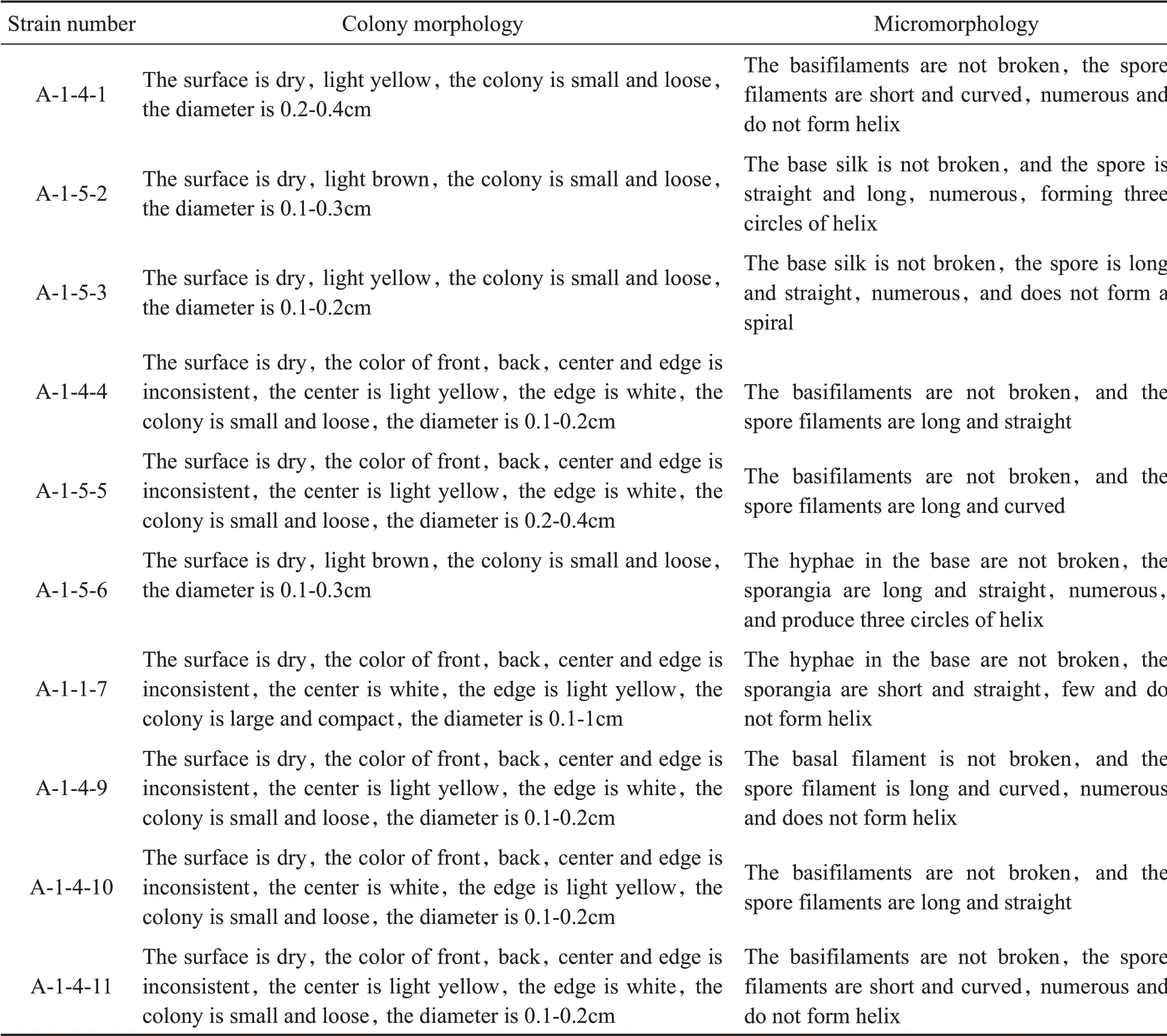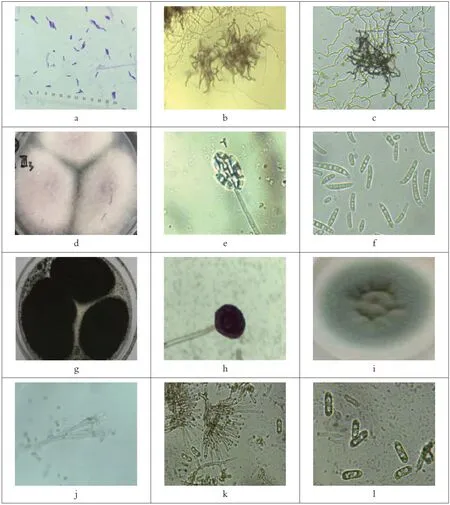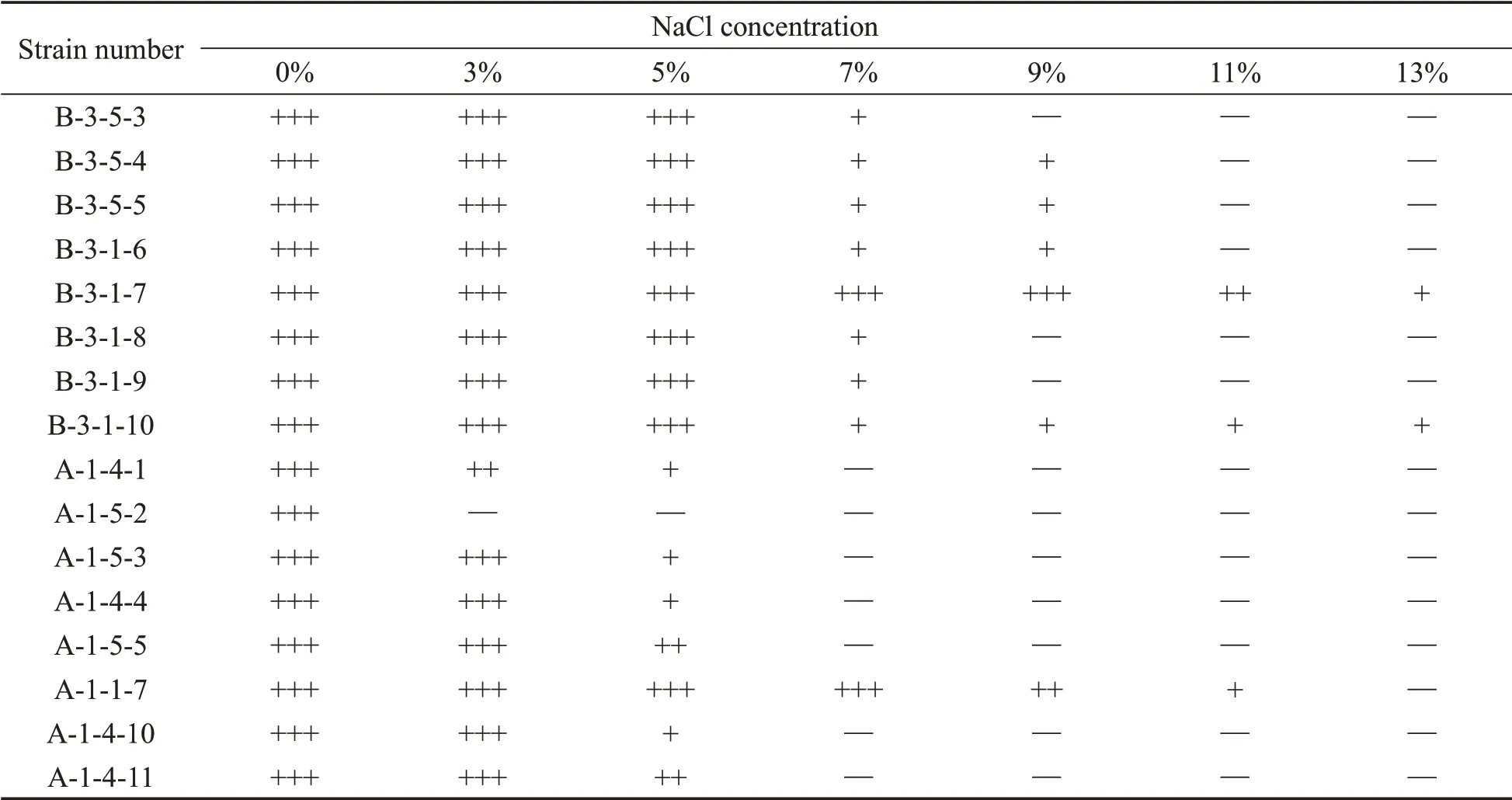Isolation and Preliminary Identification of Endophytes of Agrimonia pilosa var.nepalensis in Chuxiong
Haiyan Yang,Jianlin Shi,Huahong Chen,Lu Qiu,*
(School of Resources,Environment and Chemistry,Chuxiong Normal University,Yunnan Province 675000)
Abstract:29 endophytes were isolated from healthy plants of wild Agrimonia pilosa var.nepalensis,including 8 strains of bacteria,10 strains of actinomycetes and 11 strains of fungi.All the bacteria were bacilli and 4 strains produced spores.All actinomycetes belong to Streptomyces sp..Fungi belong to 4 genera,7 strains are Fusarium sp.,2 strains are Colletotrichum sp.,1 strain is Penicillium sp.,1 strain is Aspergillus niger.The results of growth characteristics experiment showed that the optimal growth range of all tested strains was 3%~5%NaCl concentration,6.0~8.0 pH and 20℃~35℃.The growth temperature range of bacteria was wider than that of actinomycetes.In the experiment of physiological and biochemical characteristics,strain b-3-5-4 used a wide range of carbon and nitrogen sources,while strain b-3-1-6 used a narrow range of carbon and nitrogen sources.The results showed that there were different groups of endophytes in different tissues of Agrimonia pilosa var.nepalensis.This study can provide data for further development of Agrimonia pilosa var.nepalensis.
Key words:Agrimonia pilosa var.nepalensis;endophytes;Growth characteristics;Physical and chemical properties
Agrimonia pilosavar.nepalensisis a variety of longa grass of Rosaceae.It is a perennial herb widely distributed in China,and also distributed in India,Nepal,Myanmar,Thailand and Pakistan[1,2,3].As a traditional Chinese medicine in China,A.pilosavar.nepalensiscan be used to treat flat nature and bitter taste.It has the functions of cooling blood and hemostasis,detoxifying and fighting,nourishing injury and relieving swelling,benefitingqiand strengthening heart,enhancing immunity,etc.,which is often used in the treatment of tumor,hypertension,hyperglycemia,analgesia inflammatory,digestive system diseases,etc.[4,5].The main components ofA.pilosa var.nepalensisare agrimonisin,tannin,agrimoninol,volatile oil and organic acid.The results showed that agrimonin inAgrimonia pilosa var.nepalensiscould increase the number of blood calcium and platelets,so as to shorten the coagulation time and achieve the purpose of hemostasis[6,7].A.pilosa var.nepalensisdecoction can inhibit DNA synthesis and protein expression of tumor cells,among which tannic acid is an effective anti-tumor active component,soA.pilosa var.nepalensisdecoction can be used for symptomatic treatment of tumor patients[8,9].In addition,agrimoninol in the root and bud ofA.pilosa var.nepalensishas antibacterial,tapeworm repellent and antioxidant effects[10].
Endophytes enhance or endow host plants with the ability of disease resistance,drought resistance and nitrogen fixation through co evolution with host plants.The metabolites of endophytes play an important role in plant growth and stress resistance,and will not cause obvious plant diseases,thus forming a harmonious relationship with host plants[11-14].In the late 1970s,endophytes were found in the bark and leaves of some important economic trees,such as purple shirt,eucalyptus,pine and cypress.Later,endophytes were found in many cultivated crops,such as sugarcane,corn,fruit trees,mosses,ferns and algae[15,16].An endophytic bacteria isolated fromCamellia oleiferaleaves have strong antibacterial effect onColletotrichunsp.,Rhizoctonia solani,Fusarium oxysporum,tomato early blight andCamellia oleifera[17].Penicilliumsp.isolated from Artemisia annua in Tianmu Mountain,Lin'an,Zhejiang Province,can increase artemisinin content and soluble sugar content of host plants by 58.86%and 38.24%[18].In recent years,the research of endophytes has gradually become a hot spot in the field of microbiology.
Endophytes participate in the metabolism of host plant and affect the growth of plants.For genuine medicinal materials,their properties are closely related to the climate,soil and water quality of the producing area,and their properties,organizational structure and efficacy are different under different environmental conditions[19].In the research system of genuine medicinal materials,the influence of external environment on medicinal materials is mostly studied,while the influence of plant internal environment is often ignored.Yunnan is known as"the kingdom of plants".It has rich and diverse plant resources and more Chinese medicine resources than any other areas in China.Wenshan Sanqi,Zhaotong Tianma,yunfuling and Cordyceps sinensis enjoy a high reputation in China.Some of the important medicinal plants such asParis polyphylla,Cordyceps sinensisand other endophytic bacteria research results have been used[20].With the increasing shortage of biological resources,as a kind of genuine medicinal material with wide distribution and low price,Agrimonia pilosa var.nepalensishas great application value in agriculture,industry and medicine.At present,there are few studies on Endophytic Fungi from huanglongwei,which are only limited to the screening of endophytic fungi with antitumor and antibacterial activities.Some strains screened from the fermentation products of Endophytic Fungi fromAgrimonia pilosa var.nepalensiscan inhibit the proliferation of HEH(human cervical cancer cells)and SKOV3(human ovarian cancer cells)[21].Environment of areas growning these medicinal plants is an important factor affecting the efficacy and active ingredients of traditional Chinese medicine.The community structure of Endophytes of the same medicinal plant from different producing areas is also different[22,23].Ejia is located in the west of Shuangbai County,Chuxiong,an area with a maximum altitude of 2946 meters and a minimum altitude of 800 meters.It has a large daily temperature difference,dry in winter and wet in summer.It belongs to the north subtropical monsoon climate zone.At present,there is no report about the endophytes inAgrimonia pilosa var.nepalensisof Ejia.
There are great differences in the effective components of medicinal materials from different areas,and endophytes also have a significant impact on the accumulation of effective components of medicinal materials.In this paper,the samples were collected and grown in EJia.Through the study of physiological and biochemical characteristics of endophytes inA.pilosa var.nepalensis,the growth characteristics and morphological structure of endophytes inA.pilosa var.nepalensiswere discussed to provide reference for related research and application.
1 Materials and methods
1.1 MaterialsHealthy and complete plants ofA.pilosaLedeb.var.nepalensis(D.Don)Nakai.were selected from Shuangbai Ejia,Chuxiong.
1.2 Methods
1.2.1 Cleaning and surface disinfectionAfter wound treatment,Agrimonia pilosa var.nepalensisplants were brought back to the laboratory.After the plant surface was cleaned with tap water,the root,stem and leaf of huanglongwei were cleaned with ultrasonic cleaning instrument,and then the surface was disinfected.
1.2.2 Isolation and purification of EndophytesThe isolation media were M-1(TWYE),M-4(YCED)and m-5(sodium succinate).The purification medium of actinomycetes and bacteria was TSA,and that of fungi was PDA.The culture temperature was 28℃.
1.2.3 Morphological observationThe gram properties of bacteria were determined by KOH rapid experiment,and the microscopic characteristics were observed by simple staining experiment.The culture medium of acetate agar,VBC medium,Gorodkowa agar medium and SGS medium were selected as the sporogenetic medium of fungi,and medium 1 of Gauss 1 was used as the sporogen medium of actinomycetes.The mycelium structure,sporogenetic structure and sporulation morphology of the strain were observed 15~30 days later.
1.2.4 Experiment on growth characteristics of strain
1.2.4.1 Experiment on temperature range of growthTSA medium was used as the basic medium for bacteria and actinomycetes.Six temperature gradients(4℃,10℃,20℃,30℃,35℃and 40℃)were set to study the growth temperature range of bacteria and actinomycetes.The growth of bacteria and actinomycetes was observed and recorded every day.
1.2.4.2 Experiment of NaCl concentration range in growthTSA medium was used as the basic medium for bacteria and actinomycetes.Six concentrations of NaCl(3%,5%,7%,9%,11%,13%)were set to study the range of NaCl concentration for the growth of the strain.The strain was cultured at 28℃and the growth of the strain was observed and recorded every day.
1.2.4.3 Experiment on p H range of growthTSA liquid medium was used as the basic medium for bacteria and actinomycetes.Five pH gradients were set,including pH 4.0-5.0,pH 6.0-8.0,pH 9.0-10.0,pH 11.0 and pH 12.0-13.0.The growth of the strains was observed and recorded in a 28℃incubator.
1.2.5 Experiment on physiological and biochemical characteristics of bacteriaThe micro biochemical tube produced by Hangzhou Microbial Reagent Co.,Ltd.was selected as the liquid medium for the experiment of physiological and biochemical characteristics of bacteria.Each medium was repeated for 24-72 hours at 28℃.
2 Results and discussion
2.1 Results of different isolation media for fresh plantsThe number of endophytes isolated from different isolation media is shown in Table 1.M1 medium had the least actinomycetes and the most bacteria.The most actinomycetes were isolated from M4 medium,and the most abundant endophytes were isolated from M5 medium.M1 medium is a kind of nutrient poor isolation medium,in which the carbon source,nitrogen source and growth factor provided by yeast and KH2PO4can not meet the growth needs of actinomycetes,but can meet the growth needs of bacteria.Glucose in M4 medium is the best carbon source for the growth of actinomycetes[24].The nitrogen source,growth factor and 21 kinds of amino acids produced by casein hydrolysis in yeast can provide good nutrition for the growth of actinomycetes.

Table 1 Results of different isolation media for fresh plants

Table 2 Characteristics of bacteria

Table 3 Characteristics of actinomycetes

Table 4 Characteristics of fungi
The chemical composition ofA.pilosavar.nepalensiscontains magnesium,potassium,phosphorus,iron,sulfur and other trace elements[25].The endophytes ofA.pilosavar.nepalensismust adapt to the environment containing the above elements,and the ferrous sulfate and magnesium sulfate heptahydrate contained in M5 medium can provide the above trace elements for the growth of the strain.Nystatin,rifampicin and potassium dichromate were used as inhibitors of bacteria and fungi.Nystatin and potassium dichromate can inhibit the growth of fungi,and potassium dichromate can also inhibit the growth of bacteria and stimulate the germination of actinomycetes spores.
A total of 29 endophytes were isolated fromA.pilosavar.nepalensis,among which 12 were isolated from leaves,9 from roots and the least from stems;A large number of actinomycetes and a small amount of fungi were isolated from leaves,a large number of bacteria and a small amount of bacteria were isolated from roots,and only fungi were isolated from stems.In contrast,endophytes in leaves and roots are abundant in quantity and species,with actinomycetes in leaves as the dominant flora,bacteria in roots as the dominant flora,and fungi in stems as the dominant flora,which is consistent with the result that endophytes inA.var.nepalensisof Jiangxi Province are most distributed in leaves,followed by roots and stems[26].Endophytes may invade plant leaves through rainwater,and may also invade plant roots through root cracks[27].
2.2 Endophytes morphological character
2.2.1 Endophytic bacteria morphological characteristerIt can be seen from table 2 that all the 8 strains of bacteria isolated from huanglongwei are bacilli(see Fig.1,a).Among them,there are 4 strains of Bacillus,6 strains of G+bacteria,accounting for 75%of the total,and 2 strains of G-bacteria,accounting for 25%of the total.Therefore,it can be seen that G+bacteria are the dominant bacteria.
2.2.2 Endophytic actinomycetes morphological characteristicsThe colonies of actinomycetes A-1-4-1,A-1-5-2,A-1-5-3,A-1-4-4,A-1-5-5,A-1-5-6,A-1-1-7,A-1-4-9,A-1-4-10 and A-1-4-11 were dry and hard,with light brown,white and light yellow.The basal hyphae were not broken and transparent.The spore hyphae were different in shape,long or short,straight or curved,forming or not forming helix.The mycelial morphology was consistent with that ofStreptomycessp.,and it was preliminarily identified asStreptomycesspp.(see Fig.1,b,c).
2.2.3 Endophytic fungi morphological characteristicsThe hyphae of fungi F2-4-1,F2-4-2,F2-1-3,F1-4-5,F2-1-10,F2-5-12 and F2-4-14 are flocculent and fluffy,loose,white on the front,light yellow or lavender,purplish red,yellowish brown andcyan gray on the back.The hyphae have septa and branches.Both two ends of the conidial macrospores are thin and curved,with obvious transverse septa.The conidial microspores are oval and spindle shaped,and arranged in head or string on the conidial stalk,Chlamydospores terminal or in hyphae,colorless.These above seven fungi were identified asFusariumsp.in terms of colony and conidial characteristics.
The colony of fungus F1-4-6 is powdery,with black front and gray white radial folds on the back.The flora is brownish black.The apical sac of conidia is spherical,brownish black,and the peduncle is radial,covering the whole apical sac.The characteristics of colony and conidia are consistent withAspergillussp,It is identified asAspergillus niger(see Fig.1,g,h).Its conidiophores are spherical,with double-layer petioles and brownish black globose conidia.
The mycelium of fungus F3-5-9 is fine villous and dense.The front side of the colony is turquoise green,the center is raised,the edge is flat,and the back side is yellow.The hyphae have transverse septa,and the mycelium is turquoise green.The conidiophores produce many rounds of asymmetric small stalks,which are broom shaped.The conidia are spherical,colorless and transparent.The characteristics of the colony and conidia are consistent with those ofPenicilliumsp.(see Fig.1,i,j),It was identified asPenicilliumsp.

Fig.1 Micromorphology and colony diagram of Aspergillus niger
The hyphae of fungi F2-5-13 and F2-1-15 are flocculent,loose,white on the front and bluish gray on the back.The conidial disk is oval and the conidia are cylindrical.They are produced from the bottle shaped peduncle.They have a single cell and bristles.Their colony and conidial characteristics are consistent withColletotrichumsp.,and they are identified asColletotrichumsp.(see Fig.1,k,l).
Among the 11 fungi isolated in this experiment,the number of root,stem and leaf fungi was 1,8 and 2,accounting for 9.1%,72.7%and 18.2%of the total fungi respectively.The most fungi were isolated from the stem,and the 7 fungi wereFusariumsp.,2 strains wereColletotrichumsp.and one strain wasPenicilliumsp..Among them,Fusariumsp.is the dominant flora.It is consistent with the result thatFusariumsp.is the dominant fungus ofA.pilosavar.nepalensisin Hangzhou,Zhejiang Province[28].The endophytic fungi of 4 genera were isolated in this experiment,and the most of them were isolated from the stem,which was not rich in diversity.It was because the growth of most fungi was inhibited by adding antibacterial agents in the isolation medium.The most fungi were isolated from the root ofAgrimonia pilosavar.nepalensisin Hangzhou,Zhejiang Province,while the most fungi were isolated from the stem of Ejia,ChuxiongA.pilosavar.nepalensisin this experiment,which indicated that the distribution of Endophytes in different parts of the plant was different from different acress areas.
2.3 Experimental results of growth characteristics of the strain
2.3.1 Experimental results of NaCl concentration test for strain growthAccording to the identification results of morphological structure of strains in Tables 2,3 and 4,8 strains of bacteria and 8 strains of Actinomycetes with different colony morphology and microstructure morphology were selected for the experiment of optimal growth salt concentration.The results are shown in Table 5.
It can be seen from Table 5 that the growth salt concentration range of bacteria B-3-5-3,B-3-5-4,B-3-5-5,B-3-1-6,B-3-1-8,B-3-1-9 and B-3-1-10 is 0%-5%;Bacteria B-3-1-7 grew in a wide range of 0%-13%NaCl concentration;Actinomycetes A-1-4-1,A-1-5-3,A-1-4-4,A-1-5-5,A-1-4-10 and A-1-4-11 had poor growth ability or even no growth when the salt concentration was higher than 3%,indicating that the range of growth NaCl concentra-tion of actinomycetes A-1-4-1,A-1-5-3,A-1-4-4,A-1-5-5,A-1-4-10 and A-1-4-11 was narrow.Actinomycete A-1-1-7 could grow in the range of 0%-11%NaCl,and the optimum NaCl concentration was 3%-7%.Actinomycete A-1-5-2 could not grow in the range of 3%-13%NaCl,which indicated that the strain might be non salt tolerant.With the change of environmental conditions,the growth status of plants will also change.With the increase of salt concentration,the resistance of plants to salt stress will be weakened,the chlorophyll content of plants will be reduced,and the plants will wither or even die in different degrees.The higher the salt concentration is,the worse the growth status of plants will be[29,30].Endophytes absorb nutrients from the host plant,and their growth is closely related to the internal environment of the host plant.When the host plant is in a bad environment,the growth of endophytes will also be affected.A.pilosavar.nepalensisLedeb.var.nepalensisandA.pilosaLedeb.belong to the same genus,and their growth habits are similar.It can be inferred that the growth of Endophytes ofA.pilosavar.nepalensisiweakened or even stopped with the increase of salt concentration.

Table 5 Results of NaCl concentration of strain growth
2.3.2 Test results of temperature range of strain growthAccording to Table 2,3,4 and 5,six strains of bacteria and six strains of Actinomycetes with different colony morphology,microstructure morphology and optimal growth salt concentration were selected for growth temperature range experiment.The results are shown in Table 6.
It can be seen from Table 6 that the optimum temperature range for the growth of bacteria B-3-5-3,B-3-5-5,B-3-1-6,B-3-1-7,B-3-1-8 and B-3-1-9 is wide,with vigorous growth at 4-40℃.The optimum temperature for the growth of bacteria is 37-39℃,while endophytic bacteria can grow in low temperature environment,which may be related to the temperature in the host plant.The climate of Ejia is diverse,and the temperature difference between day and night is large,which leads to the adaptation of plant and endophytic bacteria adapt to the change of environmental temperature.Actinomycetes A-1-4-1,A-1-5-3 and A-1-5-5 can grow at 4-35℃.The optimum growth temperature of A-1-4-1 is 20℃,and that of A-1-5-3 and A-1-5-5 is 20-35℃;The optimum growth temperature of A-1-5-2 was 30-35℃,and that of A-1-1-7 and A-1-4-10 was 20-35℃.
2.3.3 Test results of pH range of strain growthCombined with the experimental results in tables 4,5 and 6,four strains of bacteria and four strains of actinomycetes with different colony morphology,microstructure morphology,optimal growth salt concentration and temperature were selected to test the optimal growth pH range.The results are shown in Table 7.

Table 6 Test results of strain growth temperature range
It can be seen from Table 7 that bacteria B-3-5-4,B-3-5-5,B-3-1-6,B-3-1-7 and actinomycetes A-1-4-1,A-1-5-3,A-1-5-6,A-1-1-7 grow vigorously at pH 6.0-8.0,indicating that the optimum pH for the above eight strains is 6.0-8.0.
2.4 Physiological and biochemical testsTwo strains of bacteria B-3-5-4 and B-3-1-6 with different morphology and growth habits were selected for physiological and biochemical characteristics experiment.The results are shown in Table 8.
It can be seen from Table 8 that bacteria b-3-5-4 has a wide range of carbon source utilization,can use most of the tested carbon sources to grow,can decompose sulfur-containing amino acids in the medium to produce hydrogen sulfide,can produce lysine decarboxylase and arginine dihydrolase,and has flagella;Bacteria b-3-1-6 can only use maltose and glucose as carbon sources,can produce lysine decarboxylase and arginine hydrolase,but can not decompose sulfur-containing amino acids in the medium,and has no flagella.Bacteria b-3-5-4 was gram negative and bacteria b-3-1-6 was gram positive.There was no significant difference in growth characteristics between the two bacteria.The opti-mum salt concentration and pH range were similar,but there were significant differences in physiological and biochemical characteristics.

Table 7 Test results of p H range of strain growth

Table 8 Biological and biochemical characteristics
3 Conclusion
Among the 29 endophytes isolated and purified in this experiment,8 strains were all bacilli,2 strains were gram negative bacteria,accounting for 25%,6 strains were gram positive bacteria,accounting for 75%;All the 10 actinomycetes wereStreptomycessp.;Among the 11 fungi,7 strains wereFusariumsp.,accounting for 63.6%,2 strains wereColletotrichumsp.,accounting for 18.2%,1 strain wasPenicilliumsp.,accounting for 9.1%,and 1 strain wasAspergillusniger,accounting for 9.1%.Fusariumsp.is the dominant flora,and endophytic fungi are mostly found in the stem ofA.pilosa.The results showed that the optimal concentration of NaCl for bacteria and actinomycetes was 3%~5%,the optimal pH value was 6.0~8.0,and the optimal growth temperature was 20~35℃.In terms of colony morphology,microstructure and physicochemical characteristics,there are great differences between B-3-5-4 and B-3-1-6,and their genus or species classification still needs to be studied.

